Roasting coffee at home
I love the flavor of coffee, but don’t really care much for caffeine. Unfortunately, finding good roasters that treat decaffeinated coffee with respect is difficult, and the ones which are out there tend to either default to a dark roast, or cost enormous amounts.
But with a $20 popcorn air popper you can roast your own coffee at home, and save a lot of money doing it!
I’ve been doing it.
Equipment
Here’s a very basic home roasting setup:
- A popcorn air popper
- Some large mesh colanders
- A stopwatch, ideally with a lap timer
There are two major kinds of air poppers: side-vented, and bottom-vented. Each of them has different pluses and minuses for coffee roasting.
A side-vented popper is much easier to set up, but can’t accommodate as much coffee at a time (it’s usually limited to 60-80g).
A bottom-vented popper needs an additional bit of equipment, such as a small hand-held colander, to keep the beans from flying out, but it can also accommodate a bit more coffee at a time (around 100g) and I feel like it does a slightly better job of even roasting.
Personally I use the one by DASH, which is bottom-vented, and a cheap colander I got for like $4 at a discount store, similar to this one. And for a stopwatch I just use the app built-in to my iPhone.
People who prefer side-vented poppers typically go with this one by Nostalgia. Personally I’m liking the results I’m getting from the DASH, and might eventually buy a Nostalgia one — for popping popcorn.
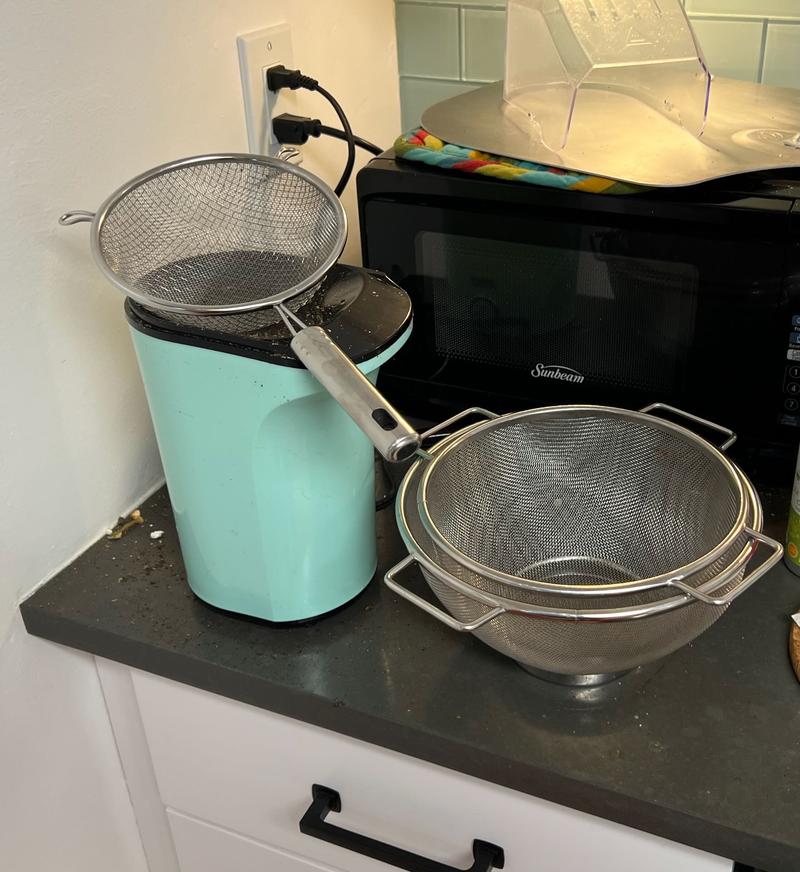
It’s also nice to have some airtight containers to keep your coffee in, ideally with a surface that you can write on with a dry-erase marker or the like. They don’t have to be very large; they just need to accommodate the roasted beans and some headroom for them to outgas. Personally, I use a bunch of these cheap ones from Target. They hold around 600mL, and I’d say as small as 400mL would probably be fine with the batch size that I do.
Beans
But of course you need beans to roast as well! If you’re in the US, Sweet Maria’s is heckin' amazing. They have several different decaf varieties and cost around $9/pound (green).
Note that when beans roast they do lose some of their weight (around 15%), so one pound of green beans works out to around 14 ounces roasted. $9 is still friggin' cheap for that though; most second-wave roasters around me charge $17 for that much (around $20/pound), and third-wave roasters are typically more like $22 for 12 ounces, or $37/pound!
For my first order I got the decaf sample set, which for me came with a Colombian blend, Ethiopia Limu Boter, Costa Rica La Pradera, and Peru Chanchamayo. Of the four, only the Ethiopia Limu Boter is currently available as a standalone purchase, which tells me that they cycle out their suppliers fairly frequently.
Anyway. Green beans are certainly interesting. They have a slightly grassy smell, and a bit spicy. It reminds me of Tabasco-flavored Cheez-It crackers (which I just learned are discontinued and that’s why I haven’t seen them in the store lately, an utter tragedy).
Update: Another source for decaf beans appears to be Genuine Origin, who offer deep discounts on large bulk purchases and also have a number of EA/sugarcane decaf products. If I ever want to purchase 65 pounds minimum I’ll definitely give them a shot… (sigh)
Here are some other sources of beans which are more accessible to the home roaster. Note that I haven’t tried any of them yet. They’re all in the US unless otherwise specified.
- Burman: nice selection of inexpensive but interesting coffees
- Lardera: much more limited selection, doesn’t seem to carry decaf
- Eight Ounce (Canada)
- Roastmasters
- Showroom: some really interesting-looking selections here, although their prices are a bit higher (as are their quality ratings)
- Coffee Bean Corral: quite affordable and has an extremely wide selection of decaf with many interesting choices, and also a very handy search engine
Update: I have bought some beans from Burman. Haven’t roasted them yet though.
Process
I start out by weighing out 100g of beans (or however much I have left of the current variety, anyway), and recording the following data on my container lid:
- Today’s date
- The bean origin/blend
- The beans' weight
- My intended post-first-crack roast time
Next, I get my roasting setup ready:
- I make sure I’m wearing shoes and have a clear path to my front door
- I take off the lid of the popper
- I put the beans into the (cold) popper
- I put the small colander on top and get my large mesh colanders ready
- I open the Stopwatch app on my phone
Finally, after I’ve gotten myself sufficiently hyped up, I do the roast:
- I simultaneously turn on the popper and start the stopwatch
- I wait for the first popping sounds to happen (usually around 3:30 in)
- I press the lap timer on my stopwatch, and then wait out the rest of my roast time
- As soon as the roast time is reached, I turn off the popper and pour the now-smoking beans into a large mesh colander
- I swish the colander around while I go to the door and walk outside
- I pour the beans back and forth between the two colanders from increasing heights to let them cool in the crisp outside air
Once they’ve cooled down to the point that they’re just vaguely warm, I weigh the result on my scale (tared to the container, of course), and record that (as well as the yield, if the starting weight wasn’t 100g) before sealing it up.
Then it’s a waiting game! Freshly-roasted coffee has way too much trapped CO2 to be brewable in anything other than an immersion brew, and it’s good to let the flavors develop over a few days anyway. I usually wait 4-5 days before I start to enjoy the roasted coffee. Otherwise you end up with shots like this one (brewed two days after roasting, just to see what would happen):
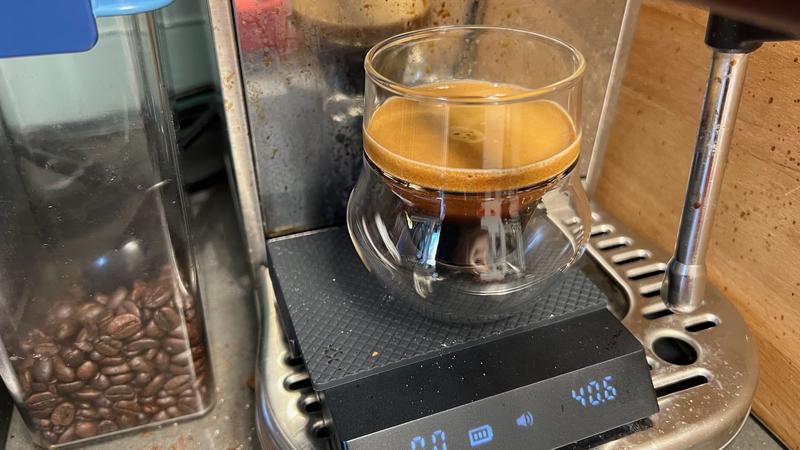
And when I do, I try to keep track of what I like and don’t like about it.
I also keep track of my dialed-in espresso grind settings on the lid, which becomes a lot more important when you’re bouncing back and forth between different roasts.
Various experiments
For my first roast I actually started out by using my oven’s air fryer mode. I didn’t get very good results from this; it was difficult to get an even roast, and the resulting coffee was much too dark for my liking. (Which is to say, it was about equivalent to the second-wave roasters. Still better than grocery-store decaf, though.)
When trying to figure out how to deal with my bottom-vented popper I tried a few different approaches to keeping the beans contained; I ended up sacrificing one of my mesh strainers to make a “collar” of sorts for the roaster to sit the other mesh strainer on, but this turns out to be unnecessary.
I also tried making a “chimney” out of tin foil with the idea of that being too tall for the beans to jump out of. It wasn’t, and they still did.
I would think that it would still be nice to get some fine mesh material to make a cylindrical “top hat” that would slip into the popper’s chamber and give the beans more vertical space to fly around, which would slow down the roast and help more flavor to develop, probably? Plus it’d make it easier to keep an eye on how dark things are getting. But at that point I’d might as well just buy a purpose-built coffee roaster.
Also, on my first few roasts I wasn’t recording the time to first crack, and thought that the “first crack” time was for when it stopped popping. Someone on the James Hoffmann discord set me straight on that, though.
Some of my roasting results
I’ve been bad at keeping a long-term record of my coffee, especially in the tasting notes, but here’s an attempt at sharing some of what I’ve learned so far, all the same.
| Variety | Date | Input | Output | Yield | FC time | Post-FC roast time | Tasting notes |
|---|---|---|---|---|---|---|---|
| Sweet Maria’s Colombian blend | 2023/09/12 | 80g | ??? | ??? | ??? | ??? | Air-fryer batch. Also I spilled part of it on the floor, and roasted it in the popper to second crack. It was still surprisingly drinkable. Would definitely not repeat this experiment. |
| 2023/09/12 | 80g | 65g | ??? | ??? | ??? | Dark and tasty, good roasty flavor, good for milk drinks. | |
| 2023/09/18 | 100g | 82g | 82% | ??? | ??? | Similarly dark and oily. Again, good for milk drinks. | |
| 2023/09/23 | 100g | 86.4g | 86.4% | ??? | 2:00 | Very nice medium-roast. Balanced, great for pourover and espresso. | |
| 2023/10/10 | 49.2g | 42.1g | 85.7% | 5:30 | 1:30 | Absolutely amazing coffee. Some of the best I’ve ever had. Last bit of the Colombian blend. | |
| Ethiopia Limu Boter | 2023/10/10 | 100g | 84.7g | 84.7% | 3:14 | 2:00 | Okay medium-light roast. Fruity and acidic, not a lot of nuance. |
| 2023/10/14 | 100g | 82.8g | 82.8% | 3:33 | 3:00 | Purposefully took it a lot darker. Good roasty flavor, a bit too burnt for pourover or espresso but makes nice milk drinks. | |
| 2023/10/23 | 100g | 87.9g | 87.9% | 3:40 | 1:00 | Quite acidic, not much flavor. | |
| 2023/10/29 | 100g | 86.8g | 86.8% | 3:51 | 1:30 | Quite acidic, not much flavor. | |
| 2023/10/30 | 53.5 | 45.7 | 85.4% | 4:15 | 2:00 | Quite acidic, not much flavor. | |
| Costa Rica La Pradera | 2023/11/4 | 100g | 85.7g | 85.7% | 3:16 | 2:30 | (not yet!) |
So, what I’ve noticed for now is that the Colombian blended coffee did better at lighter roast levels, while the Ethiopian did better at dark levels. I generally prefer lighter roasts, so I’m going to focus on South American coffee for the time being. (This also matches my prior experience with coffees I’ve enjoyed from third-wave roasters.) I’m also greatly looking forward to finding out what the other coffees in my initial order are like!
Update: I just noticed that Sweet Maria’s website actually has roasting notes, at least for varieties that they currently have in-stock. That wouldn’t have helped me for most of the beans I have, but it’d have definitely been helpful for the Limu Boter, where they recommend roasting it right up to the end of first crack (which is to say, pretty dark). Oh well, live and learn.
Also, it seems that a yield of around 85% makes for a nice medium-light roast, and 82% is on the darker side but still drinkable.
The obligatory pile of photos
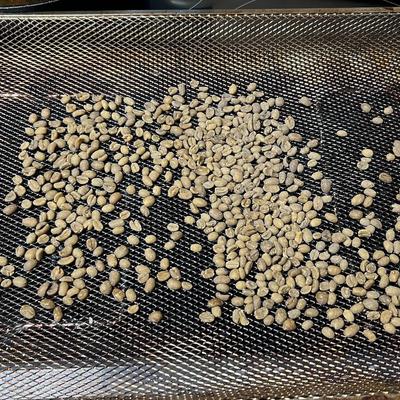
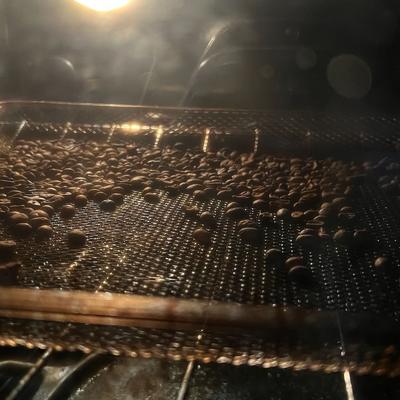

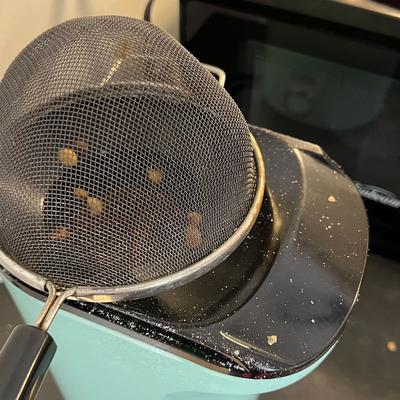


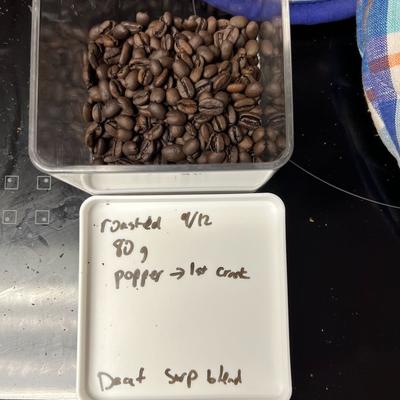
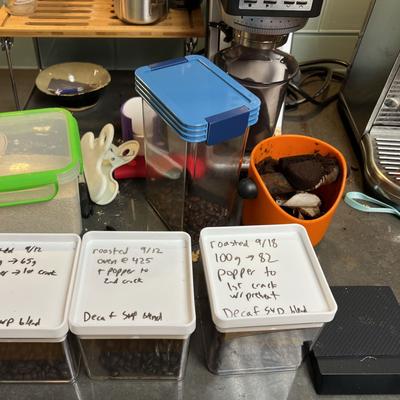
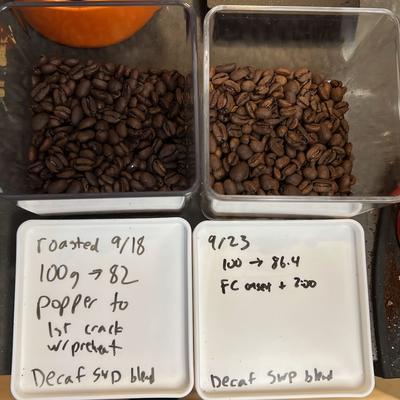


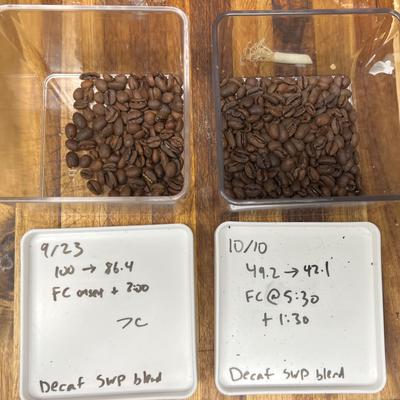
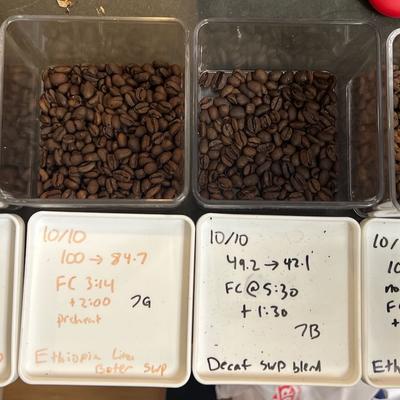

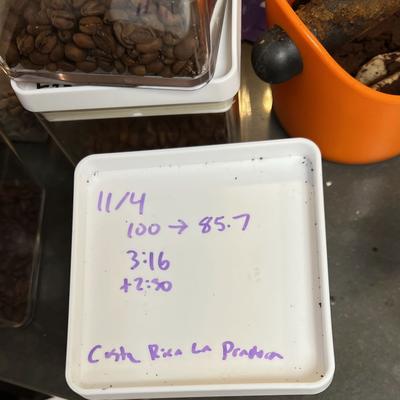
Comments
Before commenting, please read the comment policy.
Avatars provided via Libravatar